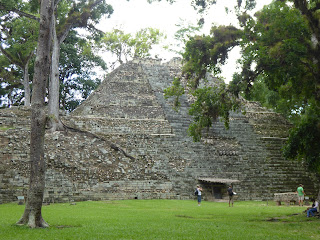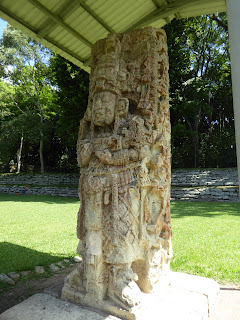Half an hour over the border into Honduras took to Copan, a small town near a large ruined Myan city. The town itself is quite small, but pretty nice. Cobbled streets that were (in my opinion) much better cobbled than Antigua was. There were also quite a lot of very steep hills, and many tuk-tuk taxis traveling at ridiculous speeds!
Dinner with the squad was at a nice, though relatively expensive place down the hill (it was happy hour, so there may have been some 'double fisting' going on). While waiting for food I kept on seeing black vultures flying past up the valley, about one every minute or so, so determined to get a better photo of one I went to wait for the next one. Then I spotted where they were going! It was quite a sight!
After dinner Dwaine (my roommate) and I went off for a wander around town to catch Pokemon. Yes, he plays too! :) Its nice to have some company in my geekiness.
Next day we went into the ruins for a guided tour around. The area the ruins are in is also being used to help reintroduce the Scarlet Macaw. As you can see we saw loads of them. They are a lot larger than I thought they would be, and fantastic colours.
The feeding stations they have for the Macaws does attract other wildlife, like wild turkey, grackles, white throated magpie jays and agouti. Agouti seem to fulfill the role squirrels do in the UK, foraging for and burying nuts, then forgetting where they buried them!
Copan (meaning 'suspended bridge' in Myan) was ruled by the same dynasty for over 800 years. Over that time the 16 rulers enhanced and added to the city, building on top of old layers of the city with new. A lot of the building decoration, stucco and painting have been discovered intact on lower layers of the city. It must have been a very colourful place! From the layers of stucco (coloured whitewash/paint) it seems that the city was repainted almost every year.
 |
| Water god? |
 |
| An alter with the 16 rulers on it |
 |
| Many human bones were discovered in these buildings. Turns out people got interred under your own house to keep your ancestors spirits close to the descendants. |
 |
| Royal podium for addressing the masses |
 |
| The wind god |
 |
| UNESCO preserved heiroglyph staircase. Steps are covered with heiroglyphs describing the deeds of various rulers |
 |
| layers of coloured stucco |
As with other Mayan cities, it seems that the population were kept in line using religion, backed by science. The educated religious elite were able to predict when the rains would start using astronomy, they then pretended to call the rains and wow'd the people by being right. Their downfall came in the form of climate change which messed up their predictions causing the last king to have to resort to threats and force to keep the people in line. This can be seen in the architecture where before there had been mostly representations of the gods, the last king adorned the structures with skulls and weapons.
The city was abandoned entirely in/after the reign of the last king (either as people lost faith in their religious leaders, the food shortages associated with the climate change, or being fed up with being threatened by their leaders) and the jungle quickly reasserted itself. This was both good and bad for archaeology. The trees grow very quickly, some going from 1 inch to 12 inches diameter in 10-15 years. The trees initially destroyed a lot of the structures roofs, but their massive roots then held together what remained stopping the rainy season from washing everything away.
Some more wildlife around the ruins included various bees nesting, an agama?, epiphytes/air plants in every tree (and on many of the power lines around), bees making nests and a humming bird (not pictured as I only saw a glimpse).
After the ruins we headed back to town for lunch (I had a proper chocolate milkshake with mine - damn tasty!), and then an hours jeep ride up a rough road to the Jaguar Moon Hot Springs and Spa for a relax. Initial impressions were poor as there were 2 large grubby looking swimming pools near reception, but then we got the tour across the bridge to the proper spa. Fed by hot springs where the water is about 70 degrees, there are about 10 pools of various temperatures, steam baths, and a fantastic hot waterfall that does a great job of massaging your shoulders, or anything else you care to place under it! Everyone had a very nice time, though the paths were a bit too stony for bare feet!




























































No comments:
Post a Comment